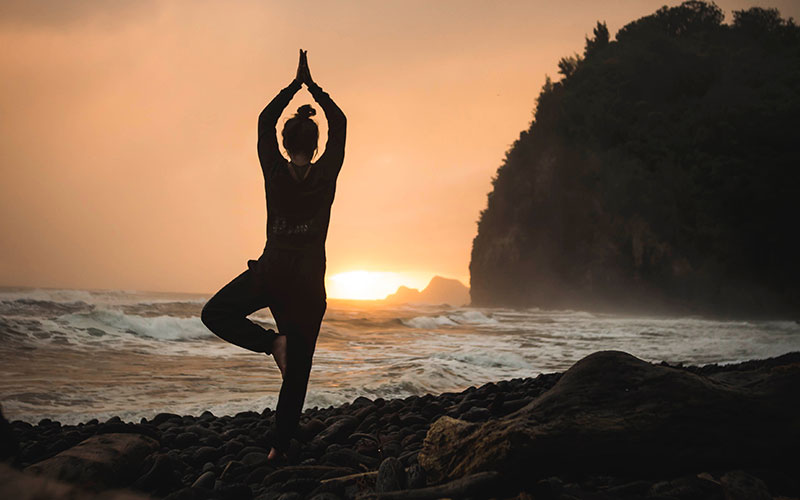Guide for Tree Pose (Vrksasana )

Guide to Tree Pose (Vrksasana)
Tree Pose, or Vrksasana, is a foundational standing yoga posture that helps improve balance, strengthen the legs, and promote focus. It’s a wonderful pose for both beginners and advanced practitioners, offering a sense of grounding and stability while encouraging mindfulness and patience.
Benefits of Tree Pose:
- Enhances balance and stability
- Strengthens the legs, especially the calves, ankles, and thighs
- Stretches the inner thighs and groin
- Improves focus and concentration
- Promotes a sense of calm and groundedness
Step-by-Step Guide:
- Begin in Mountain Pose (Tadasana):
Stand tall with your feet together and arms at your sides. Engage your core and ground through your feet, distributing your weight evenly across both legs. - Shift your weight to one leg:
Slowly shift your weight onto your right foot, keeping your leg strong and steady. Lift your left foot off the ground. - Place your foot on the inner leg:
Bring your left foot to the inside of your right leg. You can place it on your inner thigh, calf, or even keep your toes on the floor for support—avoid placing it directly on the knee. - Find balance and engage your core:
Press your left foot into your standing leg while engaging your core for stability. Keep your pelvis neutral and your spine elongated. - Hands in prayer position (Anjali Mudra):
Bring your hands to your heart in a prayer position. If you’re comfortable and balanced, you can extend your arms overhead with palms facing each other or slightly apart, resembling tree branches reaching upward. - Focus on a point:
To maintain balance, focus your gaze on a fixed point in front of you, known as a “drishti.” This will help with concentration and stability. - Hold and breathe:
Stay in the pose for 5-10 breaths, maintaining even breathing. Feel rooted through your standing leg while your upper body remains light and elongated. - Release the pose:
To come out of the pose, slowly lower your lifted foot and return to Mountain Pose. Repeat the pose on the other side.
Common Mistakes to Avoid:
- Misalignment of hips: Make sure your hips remain level and square to the front, avoiding any tilting to one side.
- Foot placement on the knee: Avoid pressing your foot directly on your knee joint, as this can cause strain.
- Leaning forward: Keep your posture tall and upright, avoiding a forward lean.
Tips for Beginners:
- If you’re struggling with balance, try practicing near a wall for support.
- Start by placing your foot lower on your leg, gradually working your way up as your balance improves.
- Keep your breath steady, as holding your breath can make it harder to maintain balance.
Advanced Variations:
- For a deeper stretch, try lifting your foot higher up the leg.
- Challenge your balance further by closing your eyes or practicing on an uneven surface like a yoga block.
Tree Pose, or Vrksasana, is a foundational standing yoga posture that helps improve balance, strengthen the legs, and promote focus. It’s a wonderful pose for both beginners and advanced practitioners, offering a sense of grounding and stability while encouraging mindfulness and patience.
Benefits of Tree Pose:
- Enhances balance and stability
- Strengthens the legs, especially the calves, ankles, and thighs
- Stretches the inner thighs and groin
- Improves focus and concentration
- Promotes a sense of calm and groundedness
Step-by-Step Guide:
- Begin in Mountain Pose (Tadasana):
Stand tall with your feet together and arms at your sides. Engage your core and ground through your feet, distributing your weight evenly across both legs. - Shift your weight to one leg:
Slowly shift your weight onto your right foot, keeping your leg strong and steady. Lift your left foot off the ground. - Place your foot on the inner leg:
Bring your left foot to the inside of your right leg. You can place it on your inner thigh, calf, or even keep your toes on the floor for support—avoid placing it directly on the knee. - Find balance and engage your core:
Press your left foot into your standing leg while engaging your core for stability. Keep your pelvis neutral and your spine elongated. - Hands in prayer position (Anjali Mudra):
Bring your hands to your heart in a prayer position. If you’re comfortable and balanced, you can extend your arms overhead with palms facing each other or slightly apart, resembling tree branches reaching upward. - Focus on a point:
To maintain balance, focus your gaze on a fixed point in front of you, known as a “drishti.” This will help with concentration and stability. - Hold and breathe:
Stay in the pose for 5-10 breaths, maintaining even breathing. Feel rooted through your standing leg while your upper body remains light and elongated. - Release the pose:
To come out of the pose, slowly lower your lifted foot and return to Mountain Pose. Repeat the pose on the other side.
Common Mistakes to Avoid:
- Misalignment of hips: Make sure your hips remain level and square to the front, avoiding any tilting to one side.
- Foot placement on the knee: Avoid pressing your foot directly on your knee joint, as this can cause strain.
- Leaning forward: Keep your posture tall and upright, avoiding a forward lean.
Tips for Beginners:
- If you’re struggling with balance, try practicing near a wall for support.
- Start by placing your foot lower on your leg, gradually working your way up as your balance improves.
- Keep your breath steady, as holding your breath can make it harder to maintain balance.
Advanced Variations:
- For a deeper stretch, try lifting your foot higher up the leg.
- Challenge your balance further by closing your eyes or practicing on an uneven surface like a yoga block.
Vrksasana is not just a physical balance pose; it also encourages mental focus and grounding. With regular practice, Tree Pose can help build strength, stability, and a deeper connection to the present moment.
